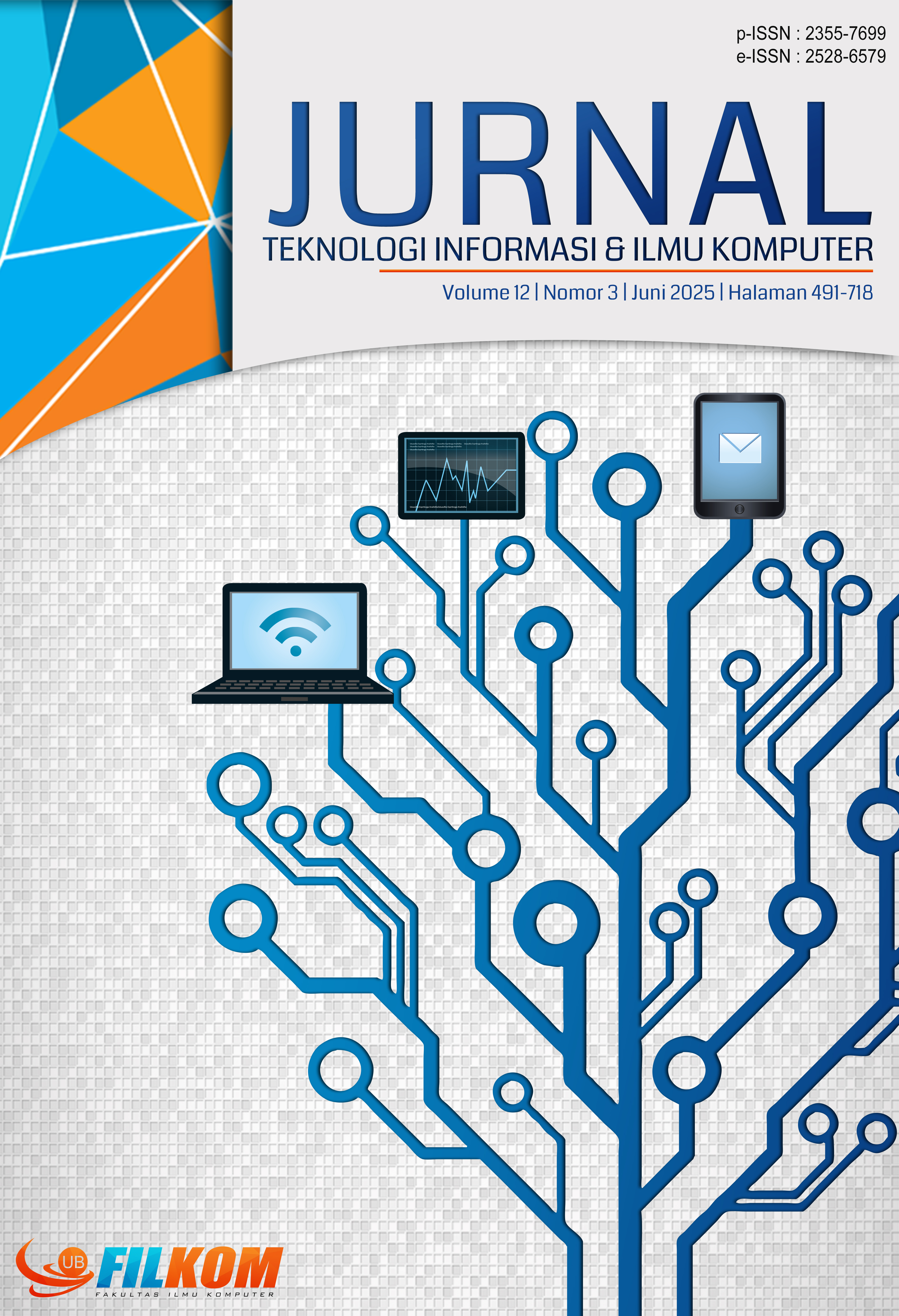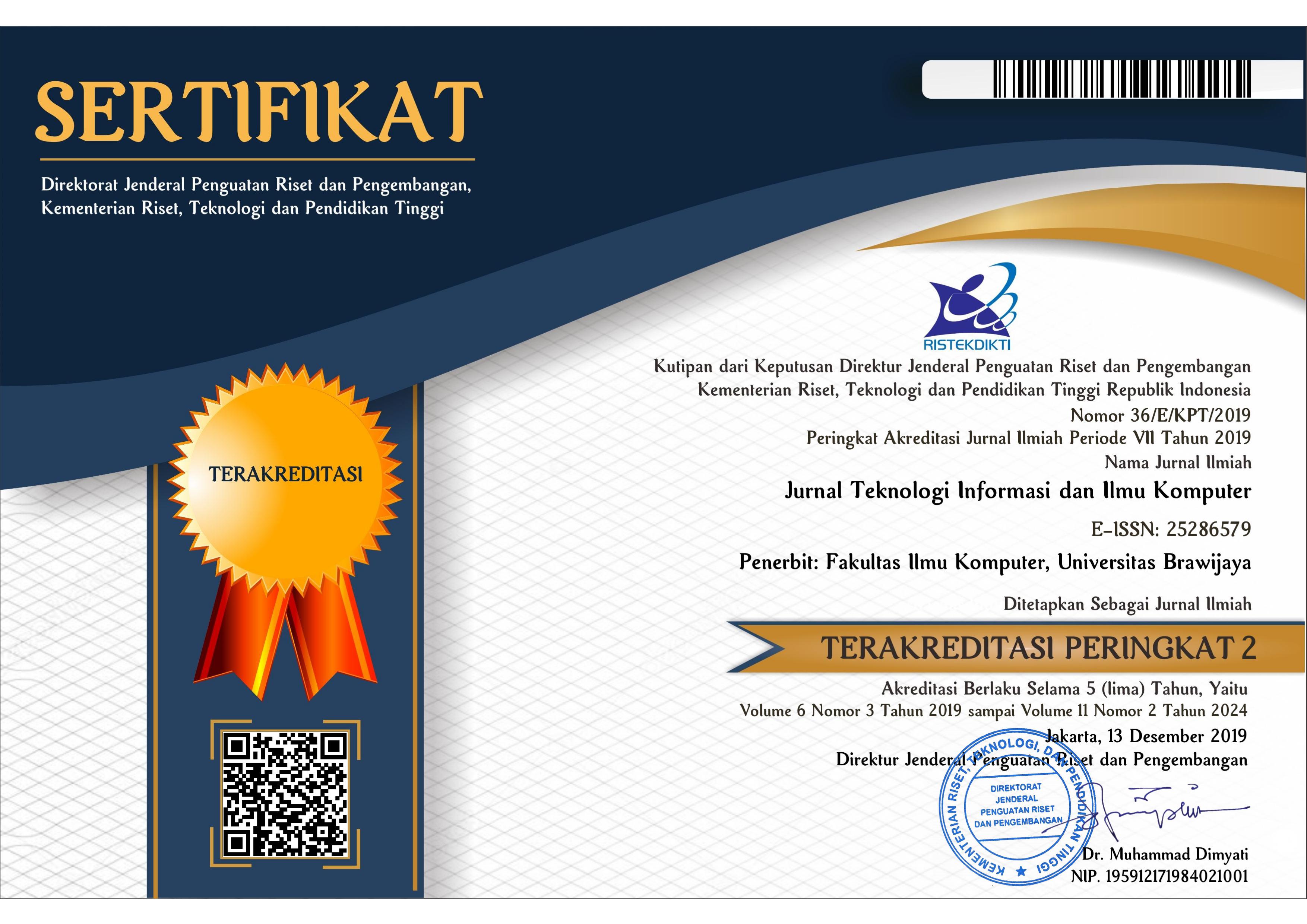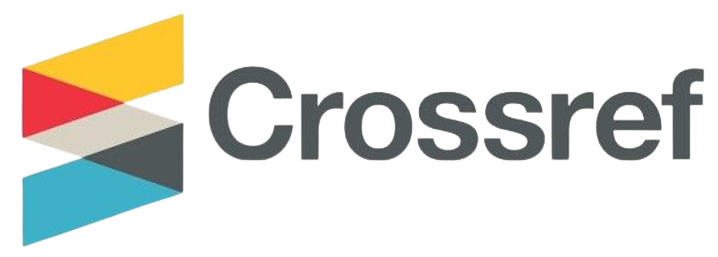Implementasi Algoritma Sparkle Schwaemm128-128 Untuk Proses Enkripsi Pengiriman Data Pada Sensor GPS berbasis IoT dengan Protokol Modul NRF24L01
DOI:
https://doi.org/10.25126/jtiik.2025129462Kata Kunci:
IoT, GPS, EnkripsiAbstrak
Penelitian ini bertujuan untuk menerapkan algoritma enkripsi Sparkle Schwaemm128-128, yang merupakan algoritma enkripsi ringan yang berdasarkan pada permutasi Sparkle, untuk proses enkripsi pengiriman data pada sensor GPS berbasis IoT dengan protokol modul NRF24L01. Metode penelitian yang digunakan adalah eksperimen dengan menggunakan perangkat keras NodeMCU ESP8266, sensor GPS NEO-6Mv2, modul komunikasi NRF24L01, dan platform Arduino IDE. Hasil penelitian menunjukkan bahwa algoritma Sparkle Schwaemm128-128 dapat mengenkripsi dan mendekripsi data sensor GPS dengan kecepatan 8012 mikrodetik untuk waktu enkripsi dan 13108 untuk waktu dekripsi. Sisa memori penggunaan pada mikrokontroler NodeMCU ESP8266 berkisar 51765 byte yaitu hanya 36,75% memori yang terpakai pada node sensor dan 52174 byte yaitu hanya 36,36% memeri yang terpakai pada node pusat. Penelitian ini diharapkan dapat memberikan solusi keamanan yang efisien dan efektif untuk sistem IoT yang menggunakan sensor GPS dan modul komunikasi NRF24L016.
Abstract
This research aims to implement the Sparkle Schwaemm128-128 encryption algorithm, which is a lightweight encryption algorithm based on Sparkle permutation, for the data encryption process in IoT-based GPS sensors with the NRF24L01 module protocol. The research method used is an experiment using NodeMCU ESP8266 hardware, NEO-6Mv2 GPS sensor, NRF24L01 communication module, and Arduino IDE platform. The results showed that the Sparkle Schwaemm128-128 algorithm can encrypt and decrypt GPS sensor data at 8012 microseconds for encryption time and 13108 for decryption. The remaining memory usage on the NodeMCU ESP8266 microcontroller ranges from 51765 bytes which is only 36.75% of the memory used on the sensor node and 52174 bytes which is only 36.36% of the memory used on the central node. This research is expected to provide an efficient and effective security solution for IoT systems that use GPS sensors and NRF24L01 communication modules.
Downloads
Referensi
AL-FUQAHA, A., ET AL., 2015. Internet of things: A survey on enabling technologies, protocols, and applications. IEEE Communications Surveys & Tutorials.
ANDERSON, R., & KUHN, M., 1996. Tamper resistance: a cautionary note. Proceedings of the 2nd USENIX Workshop on Electronic Commerce.
BEIERLE, C., ET AL., 2020. Lightweight aead and hashing using the sparkle permutation family. IACR Transactions on Symmetric Cryptology.
DAUTOV, R., ET AL., 2020. Lightweight and secure data encryption for IoT: A survey. Journal of Network and Computer Applications.
FERRAG, M. A., ET AL., 2018. A survey on privacy-preserving schemes for IoT: Current status and future directions. Journal of Network and Computer Applications.
GILL, S. S., ET AL., 2019. Transformation towards fog computing from cloud computing: A survey on security issues and solutions. Journal of Network and Computer Applications.
HAMEED, S., ET AL., 2019. Security and privacy issues in IoT: A survey. IEEE Internet of Things Journal.
HENNEBERT, C., & GLIMARE, J., 2015. Data security in the IoT: Current status and open issues. International Conference on Internet of Things.
HU, Y., & FEI, T., 2019. Efficient and lightweight encryption algorithm for IoT applications. Journal of Information Security and Applications.
NUR AZIZ, M. M., MAULANA, R., & ICHSAN, M. H. H., 2019. Implementasi Algoritme Speck pada Sistem Monitoring Detak Jantung dan Suhu. Jurnal Pengembangan Teknologi Informasi dan Ilmu Komputer, 3(9), 8680-8685. https://doi.org/10.25126/jptiik.201931964
JINDAL, A., ET AL., 2019. An evaluation of lightweight cryptographic algorithms for IoT devices. Journal of Network and Computer Applications.
JIN, X., ET AL., 2018. Lightweight encryption schemes for wireless sensor networks. Ad Hoc Networks.
MAINWARING, A., ET AL., 2002. Wireless sensor networks for habitat monitoring. Proceedings of the 1st ACM International Workshop on Wireless Sensor Networks and Applications.
NOURA, M., ET AL., 2019. Lightweight encryption algorithms for IoT: Comparative study and performance analysis. Wireless Communications and Mobile Computing.
RAZA, S., ET AL., 2017. Lightweight security solutions for the Internet of Things: A survey. IEEE Sensors Journal.
ROMDHANI, I., ET AL., 2018. Lightweight cryptography for IoT: A comprehensive survey. Ad Hoc Networks.
ROSE, K., ET AL., 2015. The internet of things: An overview. Internet Society.
RUHYAT, M. N., RAHMADEWI, R., & SARAGIH, Y., 2022. Implementasi modul transreceiver NRF24L01 sebagai pengirim dan penerima data nirkabel pada alat sistem monitoring peringatan dini banjir. Jurnal MEDIA ELEKTRIK, 19(3), 134-142.
SARDI, R.I., 2020. Implementasi Algoritme AES 128 bit Pada Mikrokontroler NodeMCU Menggunakan Arsitektur WEB SERVICE REST Untuk Keamanan Pengiriman Data. Publikasi Tugas Akhir S-1 PSTI FT-UNRAM. [online] Available at: <http://begawe.unram.ac.id/index.php/ta/article/view/150%0Ahttp://begawe.unram.ac.id/index.php/ta/article/download/150/39>...
SHIN, S., ET AL., 2020. A study on encryption algorithms for IoT applications. Journal of Ambient Intelligence and Humanized Computing.
SICARI, S., ET AL., 2015. Security, privacy and trust in Internet of Things: The road ahead. Computer Networks.
XU, L. D., ET AL., 2014. Internet of Things in industries: A survey. IEEE Transactions on Industrial Informatics.
Unduhan
Diterbitkan
Terbitan
Bagian
Lisensi
Hak Cipta (c) 2025 Jurnal Teknologi Informasi dan Ilmu Komputer

Artikel ini berlisensiCreative Commons Attribution-ShareAlike 4.0 International License.

Artikel ini berlisensi Creative Common Attribution-ShareAlike 4.0 International (CC BY-SA 4.0)
Penulis yang menerbitkan di jurnal ini menyetujui ketentuan berikut:
- Penulis menyimpan hak cipta dan memberikan jurnal hak penerbitan pertama naskah secara simultan dengan lisensi di bawah Creative Common Attribution-ShareAlike 4.0 International (CC BY-SA 4.0) yang mengizinkan orang lain untuk berbagi pekerjaan dengan sebuah pernyataan kepenulisan pekerjaan dan penerbitan awal di jurnal ini.
- Penulis bisa memasukkan ke dalam penyusunan kontraktual tambahan terpisah untuk distribusi non ekslusif versi kaya terbitan jurnal (contoh: mempostingnya ke repositori institusional atau menerbitkannya dalam sebuah buku), dengan pengakuan penerbitan awalnya di jurnal ini.
- Penulis diizinkan dan didorong untuk mem-posting karya mereka online (contoh: di repositori institusional atau di website mereka) sebelum dan selama proses penyerahan, karena dapat mengarahkan ke pertukaran produktif, seperti halnya sitiran yang lebih awal dan lebih hebat dari karya yang diterbitkan. (Lihat Efek Akses Terbuka).















